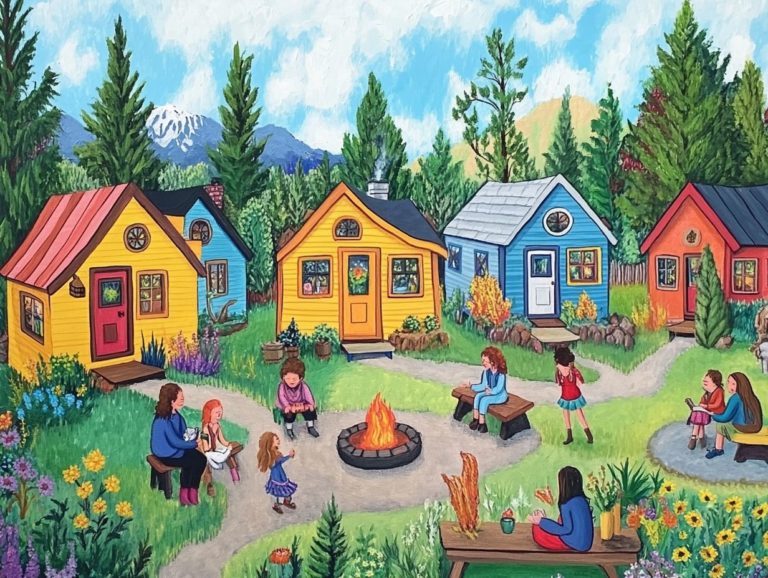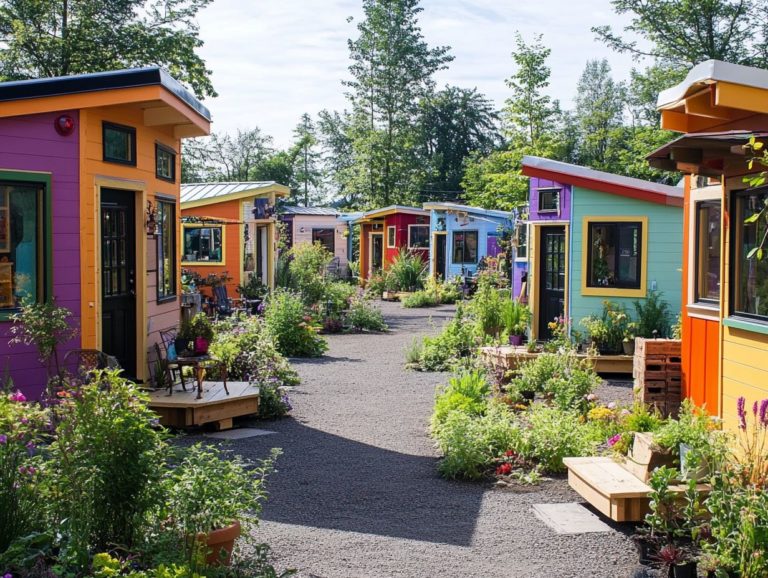7 Ways to Cultivate Community in Tiny Living
Living in a tiny space doesn t have to equate to isolation. In fact, tiny living can serve as a powerful catalyst for forging stronger connections and nurturing vibrant communities.
This article delves into seven creative ways to cultivate a sense of belonging among your neighbors, from hosting engaging community events to embarking on a shared gardening project.
It also examines the benefits and challenges of building relationships in a close-knit environment, highlighting how these interactions can enhance your personal well-being and bolster sustainability efforts.
Prepare to discover how to transform your tiny living experience into a rich tapestry of community life!
Contents [hide]
- Key Takeaways:
- 1. Get to Know Your Neighbors
- 2. Host Community Events
- 3. Share Resources
- 4. Create a Community Garden
- 5. Organize Community Clean-Ups
- 6. Start a Book or Movie Club
- 7. Volunteer in the Local Community
- How Tiny Living Can Foster a Sense of Community
- What Are the Benefits of Building a Community in Tiny Living?
- What Are the Challenges of Cultivating Community in Tiny Living?
- How Can Tiny Living Communities Support Each Other?
- What Are Some Creative Ways to Connect with Neighbors in Tiny Living?
- How Can Community in Tiny Living Help with Sustainability Efforts?
- Frequently Asked Questions
- What are the benefits of cultivating community in tiny living?
- How can shared spaces be utilized to foster community in tiny living?
- What are some creative ways to organize community events in tiny living?
- How can communication be improved in a tiny living community?
- How can conflicts be resolved in a tiny living community?
- What are some ways to welcome new members into a tiny living community?
Key Takeaways:

- Get to know your neighbors to form a strong sense of community in tiny living.
- Host events and share resources to foster connections and build relationships in a tiny living community.
- Engage in activities like community clean-ups and volunteering to support and strengthen the local community while living in a tiny home, offering encouragement and fostering lasting friendship.
1. Get to Know Your Neighbors
Getting to know your neighbors is essential for fostering a vibrant sense of community and building lasting relationships. It allows you to create meaningful connections that enhance your living environment, providing mutual support, encouragement, and friendship.
When you actively engage with those around you, you invest in a network that enriches your daily life and contributes to the overall health and vitality of your neighborhood.
These relationships can develop into a supportive network that bolsters everyone’s well-being. A simple hello or a wave can pave the way for deeper conversations about shared interests or experiences.
Organizing neighborhood potlucks or community clean-up days serves as a practical method to engage volunteers and encourage interaction. Casual chats over the fence or during your morning jog can help cultivate friendships.
By inviting neighbors into your space or participating in local events, you foster connections that create a welcoming atmosphere, making it easier to both lend and receive support in times of need.
2. Host Community Events
Hosting community events brings residents together, fostering engagement and collaboration while creating a platform for neighbors to connect over shared interests and experiences.
Imagine lively potlucks where cooking skills take center stage! Or insightful book clubs that ignite great talks these gatherings bridge gaps among diverse groups. Organizing clean-up days not only enhances the neighborhood s aesthetics but also instills a sense of pride and ownership among participants.
Volunteers play an essential role in coordinating these activities; their help turns ideas into great events that fortify community bonds. Through their efforts, lasting relationships are forged, enriching the fabric of the community and empowering individuals to contribute meaningfully to one another’s lives.
3. Share Resources
Sharing resources within your community not only cultivates a spirit of collaboration but also deepens the connections between neighbors, promoting a meaningful investment in each other’s well-being.
You can start small with community newsletters that keep everyone in the loop about local events and opportunities for engagement. Digital platforms, like Nextdoor or local Facebook groups, act as essential tools for disseminating information about skills, services, or items available for borrowing, fostering a more interconnected network.
Imagine a neighbor posting about a gardening workshop, inviting others to share their horticultural expertise or tools. This enhances mutual support and cultivates enduring relationships. By leveraging these resources, communities can create a nurturing atmosphere where individuals feel empowered to contribute and thrive collectively.
4. Create a Community Garden
Creating a community garden is a new way for you to engage with your neighbors, promote protecting the environment, and build meaningful relationships. It also provides fresh produce and a sense of accomplishment for everyone involved.
This collaborative effort not only brings people together but also improves the local ecosystem and encourages healthier eating habits. As you and your fellow community members come together to plan and cultivate the garden, you will forge connections, learn from one another, and share invaluable skills.
The sense of shared responsibility empowers residents, making everyone more invested in your neighborhood’s well-being. These gardens can pave the way for food delivery initiatives, allowing surplus produce to reach those in need and effectively tackling food insecurity while strengthening bonds within your community.
5. Organize Community Clean-Ups
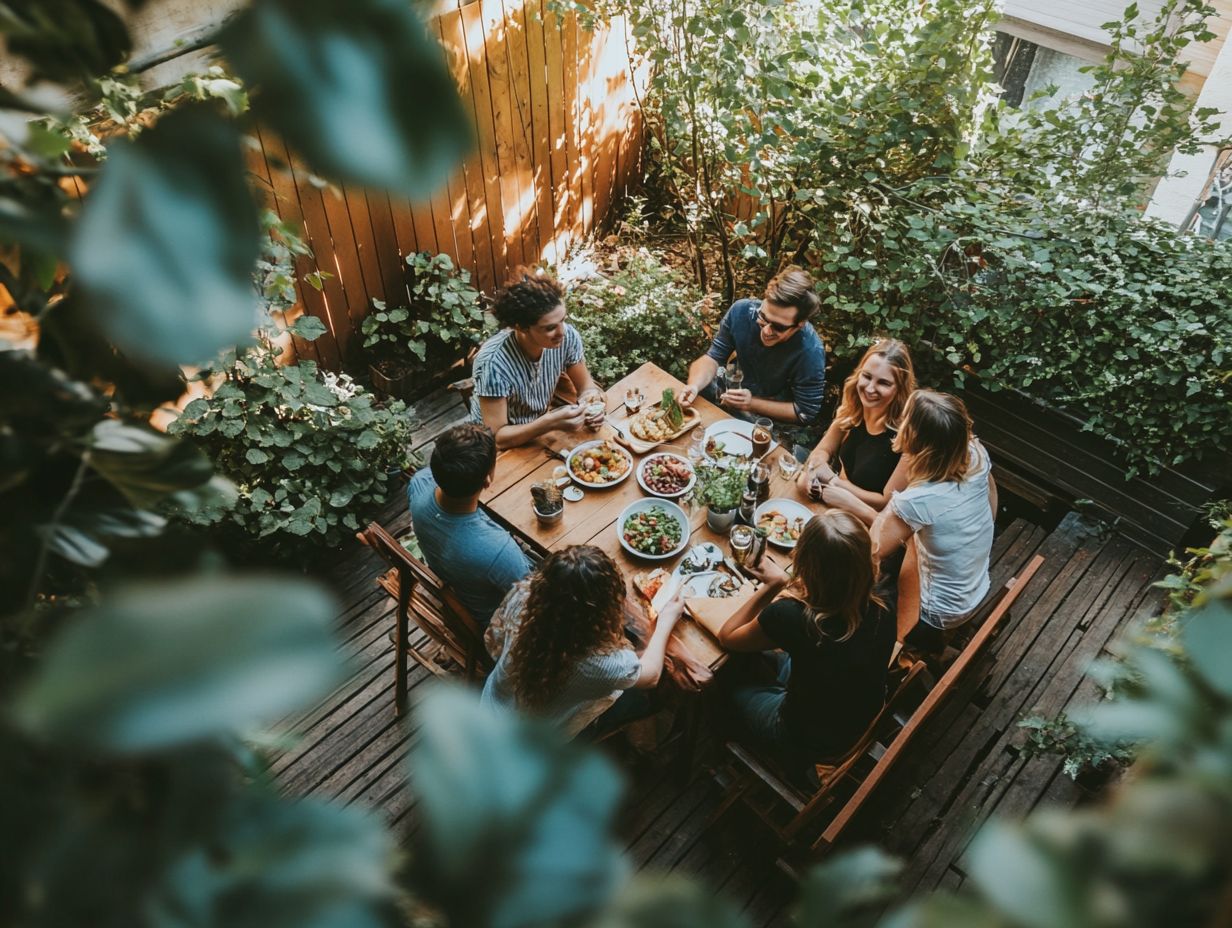
Organizing community clean-ups is a powerful way to engage residents in service while enhancing the local environment and fostering teamwork among neighbors.
Bringing together diverse groups creates a sense of belonging and shared responsibility. Interested residents can join in by signing up and dedicating their time and effort toward a common goal. As a volunteer, you play a crucial role in picking up litter and spreading the word about the initiative, expanding its reach and impact.
Partnering with local organizations like schools, businesses, or environmental groups provides valuable resources and support. As the community comes together, this clean-up initiative cultivates neighborhood pride and rejuvenates the spirit, leading to a cleaner and healthier environment for everyone involved.
6. Start a Book or Movie Club
Starting a book or movie club is a fantastic way to connect and have fun with your neighbors, offering a platform for meaningful discussions and social interactions.
By bringing together individuals who share similar interests, these clubs create a sense of belonging and invite diverse perspectives. You can experiment with various formats like rotating hosts, themed screenings, or even potluck nights which keep the experience vibrant and allow everyone to showcase their unique contributions.
When selecting materials, consider a mix of genres and styles to spark richer conversations and broaden your horizons. Regular meetings foster deeper connections, and sharing your personal interpretations of stories or films paves the way for a better understanding of one another, ultimately enriching the fabric of your community.
7. Volunteer in the Local Community
Volunteering in your local community is not just a fulfilling way to give back; it s a fantastic opportunity to connect with your neighbors and forge lasting relationships through shared experiences.
Whether you assist at local food banks or participate in environmental clean-up projects, the range of volunteer opportunities is vast. Many discover that by volunteering, they not only support important causes but also form friendships with others who share their values. This involvement in the community fosters a sense of belonging, strengthens ties among residents, and enhances the overall quality of life.
Engaging in volunteer work equips you with new skills, boosts your confidence, and cultivates greater empathy as you gain insight into the experiences of those you are helping. It s a mutually beneficial relationship that weaves a tighter social fabric for everyone involved.
Get involved today and make a difference in your community!
How Tiny Living Can Foster a Sense of Community
Tiny living can be a transformative lifestyle. It fosters a vibrant sense of community that encourages close relationships among neighbors while championing sustainability and intentional living practices.
In these compact environments, residents share resources, ideas, and experiences. This fosters bonds that can be tougher to establish in traditional living spaces.
The shared values of minimalism and eco-friendliness often spark communal activities. Think group gardening projects, potluck dinners, or workshops where skills and stories flow freely.
These interactions create a supportive network and instill a sense of accountability and collective purpose. Tiny living transcends mere downsizing; it enriches lives through deeper connections with those around you.
What Are the Benefits of Building a Community in Tiny Living?
Building a community in tiny living brings a wealth of benefits, including richer relationships, shared resources, and a robust support network that enhances your overall well-being.
In these close-knit environments, you ll find yourself enjoying communal meals or diving into group projects. These activities create connections that deepen beyond mere acquaintances.
When challenges arise, emotional support shines through. Neighbors come together to help each other navigate the ups and downs of downsizing or adjusting to new living conditions.
Practical assistance is at your fingertips with shared tools, enabling collaborative gardening or maintenance tasks. This saves you time and money while strengthening the bonds between community members.
Shared experiences through workshops or social gatherings forge lasting memories. They reinforce a sense of belonging that transforms tiny living into a vibrant lifestyle rather than a solitary endeavor. For those interested in enhancing their community, learning how to implement sustainable practices in tiny living can be incredibly beneficial.
What Are the Challenges of Cultivating Community in Tiny Living?
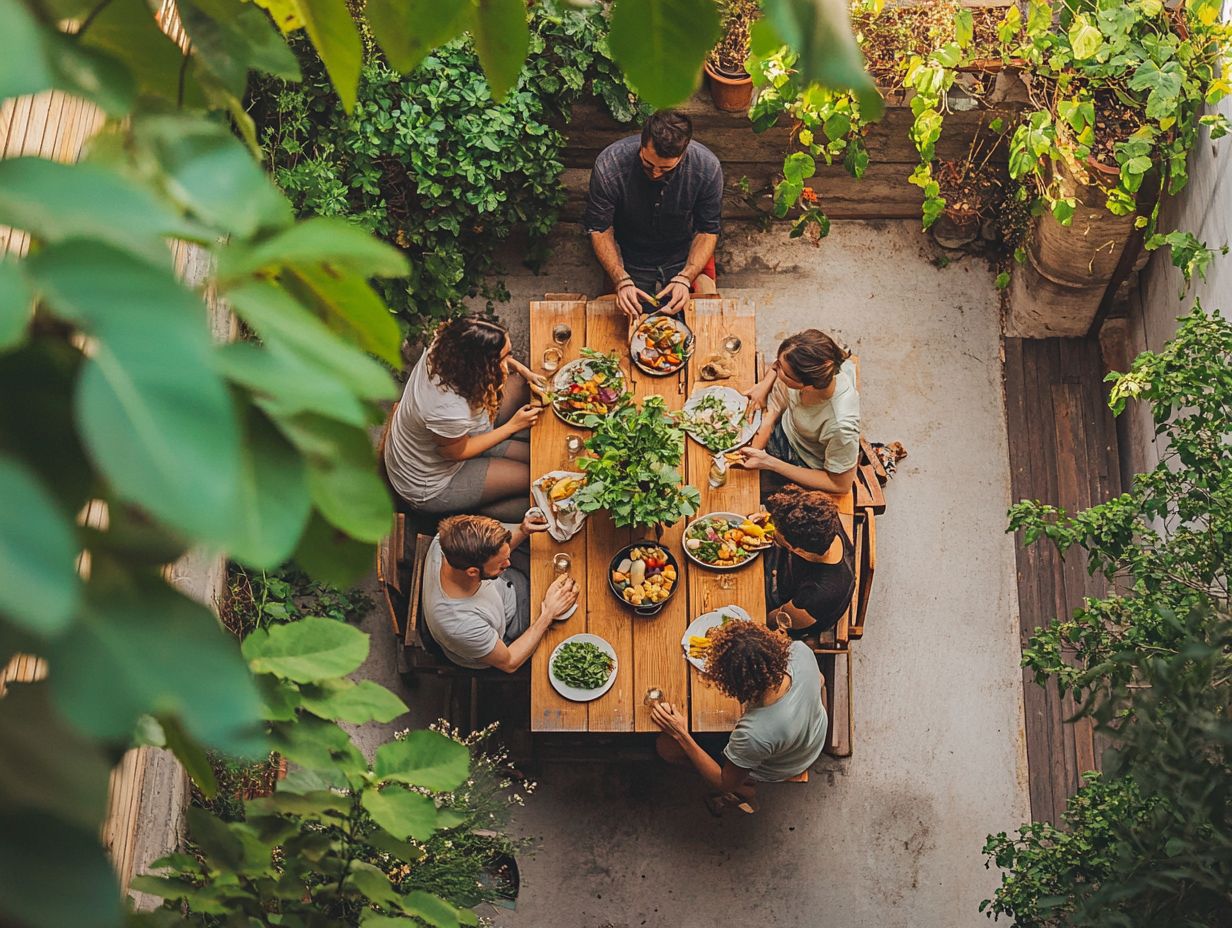
Cultivating a tiny living community opens doors to amazing benefits, but it also brings its share of challenges. These include space limitations, varying lifestyles, and the necessity for active participation among residents.
These hurdles can lead to friction and misunderstandings if not addressed with care. For example, the scarcity of communal areas may hinder individuals from forging common ground. You might feel isolated or overwhelmed by the diverse habits and routines of your neighbors.
To navigate these tensions effectively, establishing clear communication from the outset is essential. This allows everyone to express their needs and concerns openly.
Hosting regular meetings can create a sense of belonging and shared purpose. Collaboratively crafting community guidelines can align values and expectations, ensuring a harmonious living experience for all. This makes tiny living not just manageable, but truly enjoyable, especially when implementing 7 ways to enhance functionality in tiny spaces.
How Can Tiny Living Communities Support Each Other?
Tiny living communities have the potential to transform your experience. They foster mutual support, encourage engagement, and nurture a culture of sharing and collaboration.
When you establish a framework for resource sharing, you open the door for members to exchange tools, appliances, and even expertise. This minimizes costs and maximizes utility.
Skill exchanges present a valuable opportunity for growth. You can teach gardening, carpentry, or cooking in exchange for learning painting or sewing.
Collaborative projects like community gardens or repair workshops enhance the physical environment while deepening interpersonal bonds. This interconnectedness strengthens relationships and cultivates a profound sense of belonging, enabling you and your neighbors to thrive both individually and collectively.
Explore the potential of tiny living communities and share your experiences to inspire others!
What Are Some Creative Ways to Connect with Neighbors in Tiny Living?
Finding creative ways to connect with your neighbors in small living spaces can transform your community into a lively mix of experiences, enriching everyone through new ways to connect.
Whether you re hosting themed gatherings that celebrate various cultures or simply sharing a meal, these activities can break down barriers and spark open dialogue. Organizing group events like potlucks or outdoor movie nights creates a relaxed atmosphere where community members can forge genuine relationships.
Being intentional about these interactions ensures that the bonds formed are meaningful connections that enhance everyone s lives. Each gathering becomes an opportunity to truly understand and appreciate the diverse backgrounds and stories that each neighbor brings to the table.
How Can Community in Tiny Living Help with Sustainability Efforts?
Community living in tiny spaces significantly enhances sustainability efforts. It encourages you to share resources, engage in collective actions, and participate in eco-friendly practices.
In these vibrant living arrangements, you can connect with your neighbors to establish community gardens. Here, you not only cultivate fresh produce but also build meaningful relationships.
These green spaces become a source of nourishment and a hub for educational workshops focused on sustainable gardening techniques. Recycling programs within these micro-communities foster waste reduction and promote responsible consumption habits, giving you the power to take ownership of your environmental footprint.
By implementing resource-sharing systems, such as tool libraries and car-sharing options, you can reduce excess consumption while enjoying a stronger sense of camaraderie. This ultimately leads to improvements both for the environment and your social connections.
Frequently Asked Questions
What are the benefits of cultivating community in tiny living?
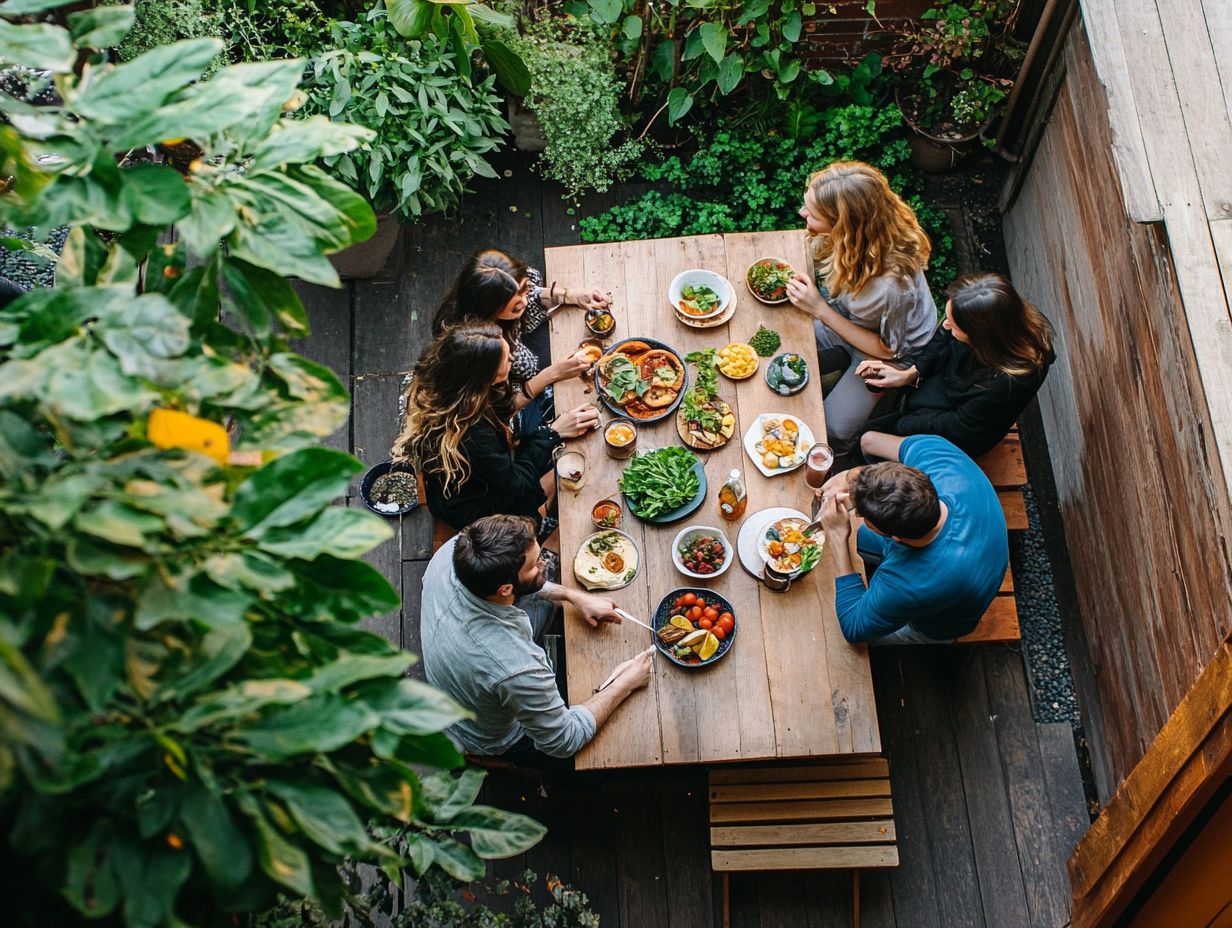
In addition to a sense of belonging and support, cultivating community in tiny living can foster a spirit of homesteading, the practice of growing your own food and living sustainably. This encourages members to grow their own food and participate in local economies.
It can also lead to cost-sharing opportunities, increased safety, and a more sustainable way of living.
How can shared spaces be utilized to foster community in tiny living?
Shared spaces such as community gardens, common areas, and communal kitchens bring people together and encourage interaction and collaboration. They promote a sense of shared responsibility and ownership among residents, which is essential for engaging the entire community.
What are some creative ways to organize community events in tiny living?
Join together for potluck dinners, movie nights, game nights, or book clubs! Other ideas include hosting workshops, skill-sharing sessions, or outdoor activities like hikes or picnics.
By organizing a conference focused on local crafts and talents, you can celebrate the skills within your community. Let s make the most of our tiny living spaces!
How can communication be improved in a tiny living community?
A group chat, community bulletin board, or regular house meetings can significantly enhance communication among residents. Clear channels help everyone stay informed and connected.
How can conflicts be resolved in a tiny living community?
Conflicts are common in any community, especially in tiny living spaces. Establishing open communication and a clear conflict resolution process is essential.
This process may include having a mediator, setting ground rules, and practicing active listening. Using wisdom from Proverbs 13, which emphasizes the importance of wise discussions, can guide these conversations.
What are some ways to welcome new members into a tiny living community?
Welcoming new members fosters a sense of belonging. A welcome committee, housewarming party, or simply reaching out can make them feel included.
Offering help with settling in and sharing information about local online communities can also be beneficial.

